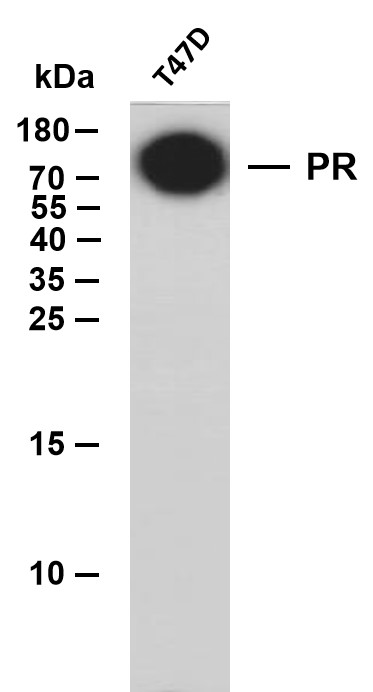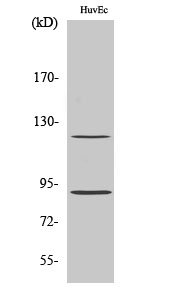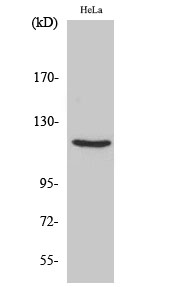Progesterone Receptor(PR) (ABT-PR.1) Mouse mAb
- Catalog No.:YM6763
- Applications:IHC;WB;ELISA
- Reactivity:Human (predicted: Mouse; Rat; Rabbit)
- Target:
- PR
- Fields:
- >>Oocyte meiosis;>>Progesterone-mediated oocyte maturation;>>Estrogen signaling pathway;>>Chemical carcinogenesis - receptor activation;>>Breast cancer
- Gene Name:
- PGR NR3C3
- Protein Name:
- Progesterone Receptor(PR)
- Human Gene Id:
- 5241
- Human Swiss Prot No:
- P06401
- Immunogen:
- Synthesized peptide derived from human Progesterone Receptor(PR) AA range: 200-300
- Specificity:
- This antibody detects endogenous levels of human Progesterone Receptor(PR), TRIS-EDTA of pH9.0 was used for Heat-induced epitope retrieval (HIER). The antibody was also Predict react with Mouse;Rat
- Formulation:
- Liquid in PBS containing 50% glycerol, 0.5% BSA and 0.02% sodium azide.
- Source:
- Mouse, Monoclonal/IgG1, Kappa
- Dilution:
- IHC 1:50-500, WB 1:200-1000, ELISA 1:5000-20000
- Purification:
- The antibody was affinity-purified from mouse ascites by affinity-chromatography using specific immunogen.
- Storage Stability:
- -15°C to -25°C/1 year(Do not lower than -25°C)
- Other Name:
- Progesterone receptor (PR;Nuclear receptor subfamily 3 group C member 3)
- Molecular Weight(Da):
- 99kD
- Background:
- This gene encodes a member of the steroid receptor superfamily. The encoded protein mediates the physiological effects of progesterone, which plays a central role in reproductive events associated with the establishment and maintenance of pregnancy. This gene uses two distinct promotors and translation start sites in the first exon to produce several transcript variants, both protein coding and non-protein coding. Two of the isoforms (A and B) are identical except for an additional 165 amino acids found in the N-terminus of isoform B and mediate their own response genes and physiologic effects with little overlap. [provided by RefSeq, Sep 2015],
- Function:
- domain:Composed of three domains: a modulating N-terminal domain, a DNA-binding domain and a C-terminal steroid-binding domain.,function:Isoform A is inactive in stimulating c-Src/MAPK signaling on hormone stimulation.,function:The steroid hormones and their receptors are involved in the regulation of eukaryotic gene expression and affect cellular proliferation and differentiation in target tissues. Progesterone receptor isoform B (PRB) is involved activation of c-SRC/MAPK signaling on hormone stimulation.,online information:Progesterone receptor entry,PTM:Phosphorylated on multiple serine sites. Several of these sites are hormone-dependent. Phosphorylation on Ser-294 occurs preferentially on isoform B, is highly hormone-dependent and modulates ubiquitination and sumoylation on Lys-388. Phosphorylation on Ser-102 and Ser-345 also requires induction by hormone. Basal phosphorylation on Se
- Subcellular Location:
- Nucleus. Cytoplasm. Nucleoplasmic shuttling is both hormone- and cell cycle-dependent. On hormone stimulation, retained in the cytoplasm in the G(1) and G(2)/M phases.; [Isoform A]: Nucleus. Cytoplasm. Mainly nuclear.; [Isoform 4]: Mitochondrion outer membrane .
- Expression:
- In reproductive tissues the expression of isoform A and isoform B varies as a consequence of developmental and hormonal status. Isoform A and isoform B are expressed in comparable levels in uterine glandular epithelium during the proliferative phase of the menstrual cycle. Expression of isoform B but not of isoform A persists in the glands during mid-secretory phase. In the stroma, isoform A is the predominant form throughout the cycle. Heterogeneous isoform expression between the glands of the endometrium basalis and functionalis is implying region-specific responses to hormonal stimuli.
- June 19-2018
- WESTERN IMMUNOBLOTTING PROTOCOL
- June 19-2018
- IMMUNOHISTOCHEMISTRY-PARAFFIN PROTOCOL
- June 19-2018
- IMMUNOFLUORESCENCE PROTOCOL
- September 08-2020
- FLOW-CYTOMEYRT-PROTOCOL
- May 20-2022
- Cell-Based ELISA│解您多样本WB检测之困扰
- July 13-2018
- CELL-BASED-ELISA-PROTOCOL-FOR-ACETYL-PROTEIN
- July 13-2018
- CELL-BASED-ELISA-PROTOCOL-FOR-PHOSPHO-PROTEIN
- July 13-2018
- Antibody-FAQs
- Products Images

- Whole cell lysates were separated by 15% SDS-PAGE, and the membrane was blotted with anti-PR(ABT-PR.1)antibody. The HRP-conjugated Goat anti-Mouse IgG(H + L) antibody was used to detect the antibody. Lane 1: T47D Predicted band size: 99kDa Observed band size: 99kDa
.jpg)
- Human breast carcinoma tissue was stained with Anti-Progesterone Receptor (ABT-PR.1) Antibody
.jpg)
- Human breast carcinoma tissue was stained with Anti-Progesterone Receptor (ABT-PR.1) Antibody


.jpg)
